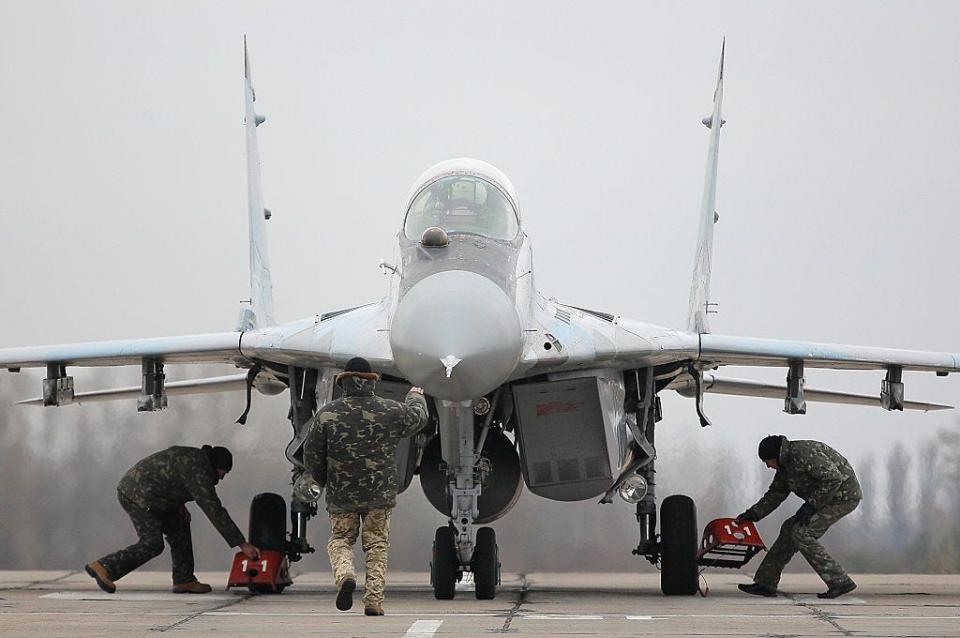Ukraine's air force has gotten good at fighting on the run, and Russia's military can't catch up, top US general says
Ukraine's air force has been able to keep operating by spreading out its jets among different bases.
Russia has struggled to catch up to that dispersal, the top US Air Force general in Europe says.
That success underscores the US Air Force's need to be able to distribute its jets and crews.
During 18 months under attack by Russia's bigger and better-armed military, Ukraine's air force has kept its jets in action by staying on the move. Its success is due in part to Russia's shortcomings in finding and striking targets, and it has lessons for the US and its allies, the top US Air Force general in Europe said this week.
"If you look at what Ukraine's doing right now, they very seldom will take off and land at the same airfield. They take off and then land at another airfield," Gen. James Hecker, head of US Air Forces in Europe, told reporters at the Air and Space Forces Association conference, held near Washington DC.
"Because of that, they've had very few of their aircraft that died on the ground," Hecker added.
Russia began the war with a larger and more advanced air force, including better radars and longer-range missiles. A British assessment published in July said that despite losing 86 fixed-wing aircraft, Russia still had 96% of its fleet left, while Ukraine had lost 68 aircraft and had 78% of its inventory remaining.

Ukraine has benefited from getting Western-made weapons, including guided bombs and cruise missiles, that are modified to work with its Soviet-era jets and allow them to strike Russian ground targets at longer distances, but those jets are still getting airborne to launch those strikes because they are moving from base to base before Russian forces can catch up, Hecker said.
"They're always changing it up, and they're doing it inside the targeting cycle of Russia," Hecker said, referring to the process by which targets are identified, tracked, and struck. "And it's been very successful."
Timely and accurate targeting, especially against targets that can move, has been one of the Russian air force's most notable shortcomings during the war and reflects its general inability to conduct complex operations.
Despite compiling detailed and generally accurate target lists focused on Ukraine's air defenses in the months ahead of its February 2022 attack, Russia failed to destroy many of Ukraine's mobile air-defense weapons, which Kyiv, on alert and with warnings from foreign partners, was able to reposition before the Russian strikes began.
After those opening attacks, the Russian process for detecting a target, tracking it, and assigning a strike mission to it — which could take 48 hours or longer — couldn't keep up with Ukrainian air-defense forces that were dispersed and relocated after firing.

While Russia's air force "continues to reliably cause damage" to Ukrainian infrastructure and logistical targets, it can't effectively destroy Ukraine's mobile air defenses or effectively perform close air support, Justin Bronk, an air-warfare expert at Britain's Royal United Services Institute, wrote in a report published in April.
"Both of these deficiencies essentially boil down to an inability to reliably find, fix, identify, and accurately strike dynamic mobile targets in a contested air environment" and prevented Russia's air force "from exerting a decisive effect against Ukraine in 2022," Bronk wrote.
Dara Massicot, a senior fellow at the Carnegie Endowment for International Peace, attributed the Russian air force's targeting failings to "structural reasons," including "serious limitations" in its intelligence, surveillance, and reconnaissance operations, both by aircraft and space-based assets.
Russian commanders have also "made questionable targeting decisions on Ukrainian air bases from the start of the war," Massicot, an expert on the Russian military, said on a podcast in April.
Massicot cited Russia's claims about destroying more HIMARS launchers than Ukraine actually had as evidence of another deficiency: "This goes back to Russian BDA, battle damage assessment, whether it's relying on pilots or relying on ground units to report accurately and honestly," Massicot said. "Things are coming into the system that are junk and rattling around in Moscow and influencing their assessments."

For Hecker, the Ukrainian air force's success in fighting on the move underscores the need for the US Air Force to focus on its approach to distributed operations, known as Agile Combat Employment, or ACE.
ACE predates the war and is being developed with an eye toward the Pacific theater, where US Air Force officials worry that China's growing arsenal of long-range weapons could damage or knock out the main US bases early in a war.
While Russia has struggled to hit targets in Ukraine, Hecker and other officials say the proliferation of precision weapons, like cruise missiles or one-way drones, means the US and its allies can't afford to congregate at a few large bases, where aircraft, munitions, fuel, and personnel are more vulnerable to attacks.
"We were working this concept of ACE well before the Ukraine war started, but it kind of validated what we're trying to do, and of course, we have to move these aircraft inside of the targeting cycle of the enemy," Hecker said.
US Air Forces in Europe conducted a major ACE exercise in August, which saw allied aircraft operate from unfamiliar bases in Latvia and Finland. Hecker said his command is "picking different places" to do ACE and putting equipment at those locations to support those operations, "and we're working on cross-servicing agreements, where other countries can give you fuel and those kinds of things at these different bases."
"We need to make sure that our airplanes and our assets don't get killed on the ground, and through agile combat deployment, we can make sure that this happens," Hecker said.
Read the original article on Business Insider

 Yahoo News
Yahoo News 
